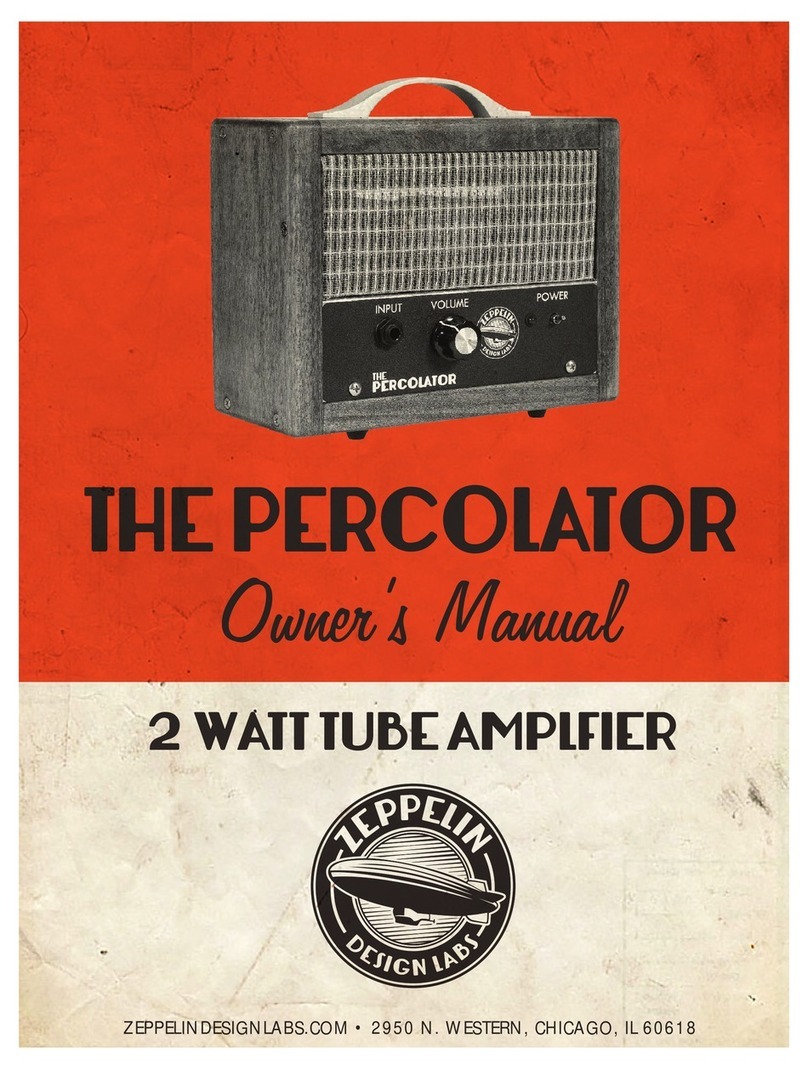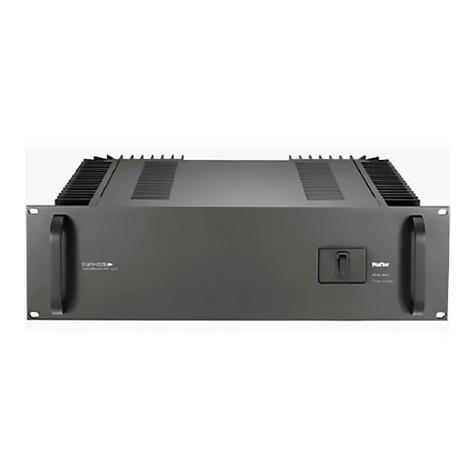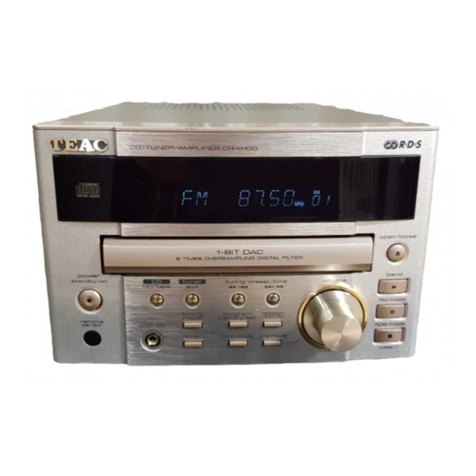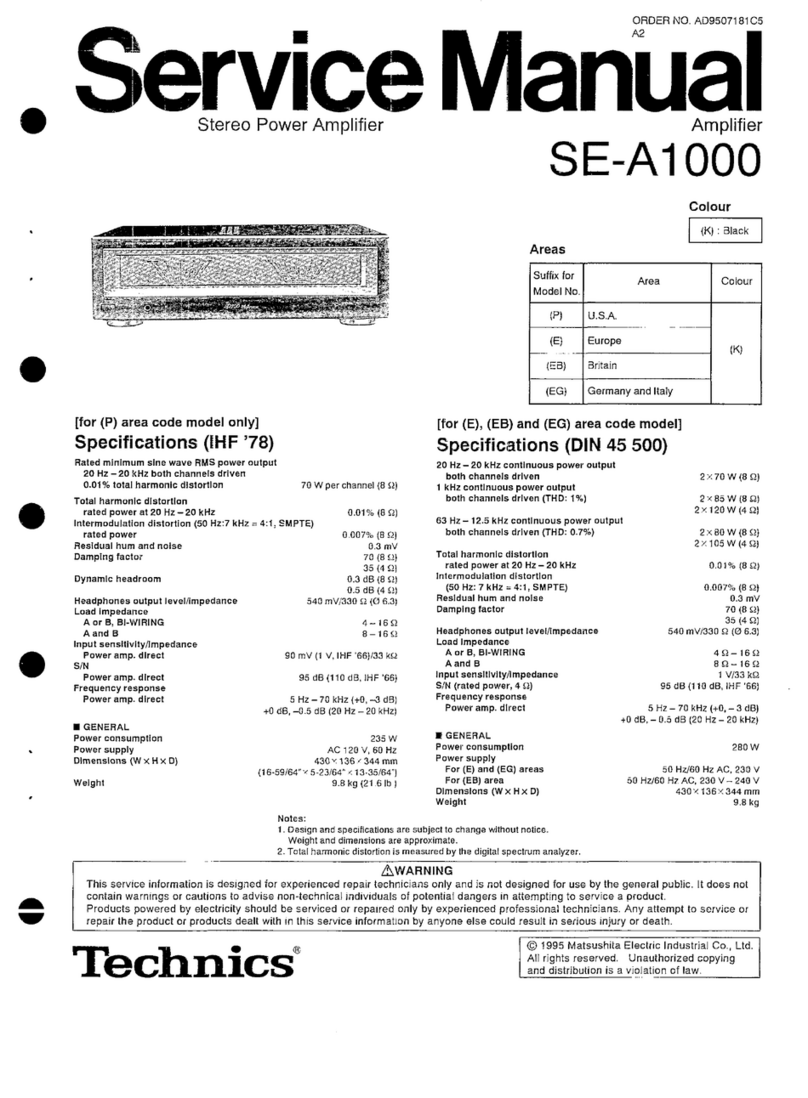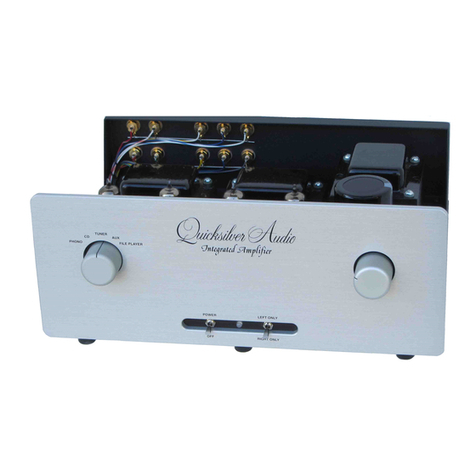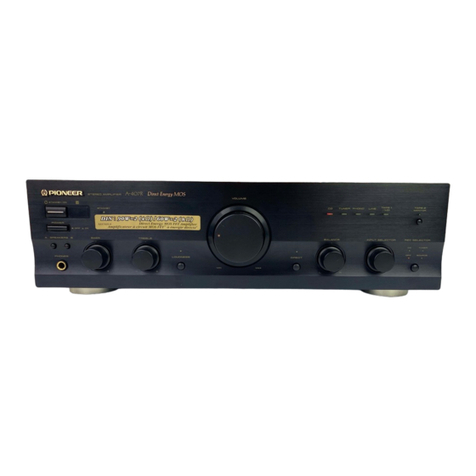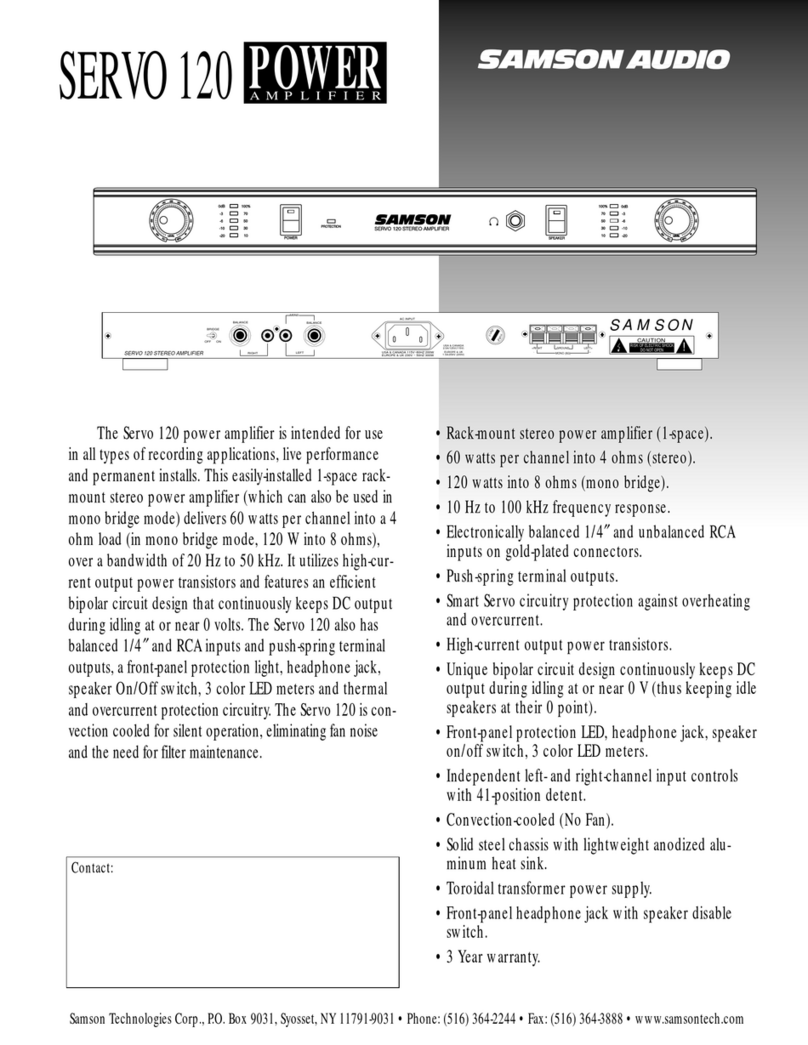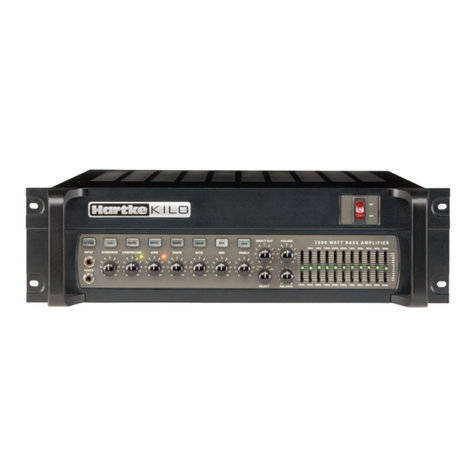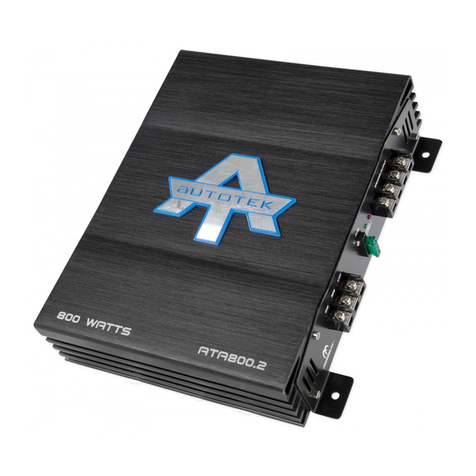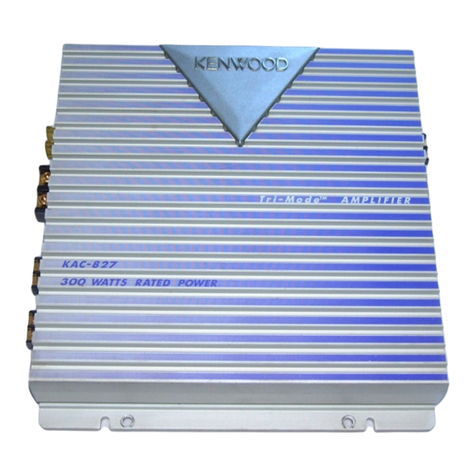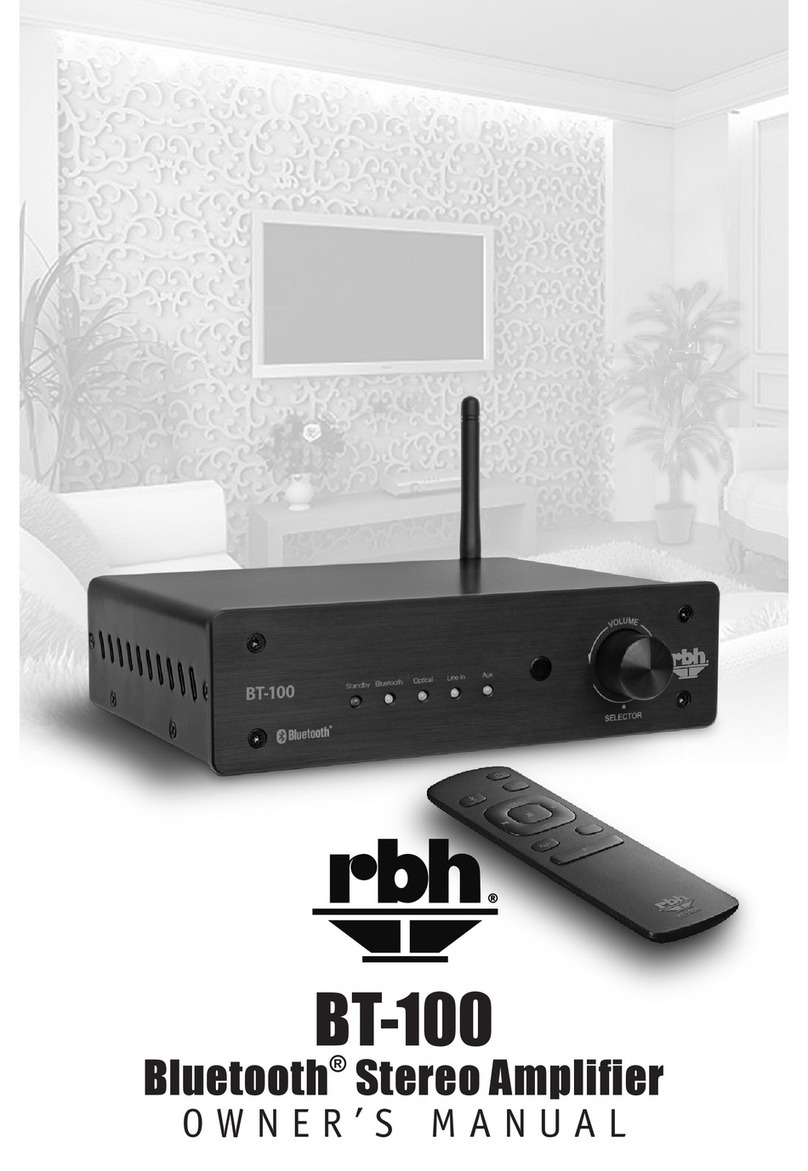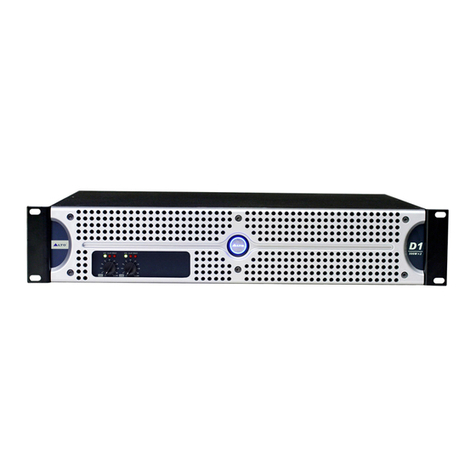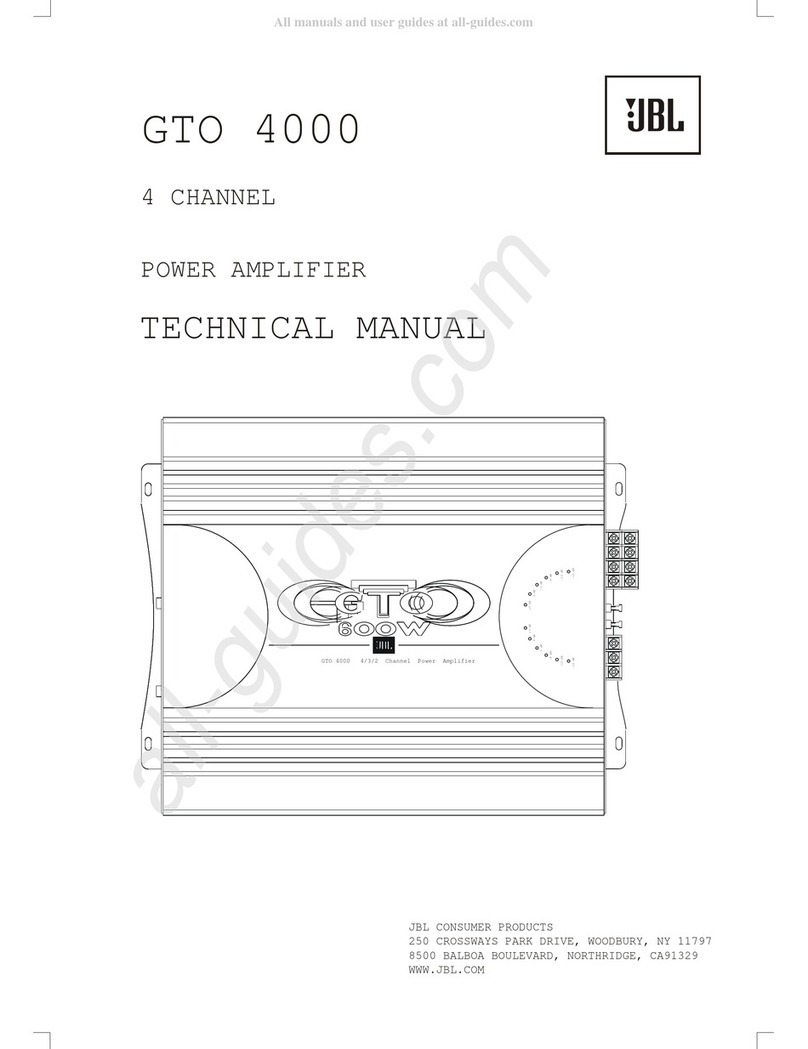Zeppelin THE PERCOLATOR User manual

THE PERCOLATOR COMBO
ZEPPELINDESIGNLABS.COM • 2950 N. WESTERN, CHICAGO, IL 60618
Assembly Instructions
2
WATT AMPLIFIER KIT

2
THE PERCOLATOR
2 Watt Tube Amp / 1x8 Combo Kit Assembly Instructions
INTRODUCTION ...................................................................................................... 3
CAUTIONS, WARNINGS, DANGERS ......................................................................... 3
BUILDING THE AMPLIFIER.......................................................................................... 4
WHAT YOU WILL NEED ......................................................................................... 4
WHAT’S IN THE BOX............................................................................................. 6
POPULATING THE PRINTED CIRCUIT BOARD.......................................................... 11
LOADING THE CHASSIS ...................................................................................... 24
TESTING THE AMP .............................................................................................. 38
ASSEMBLING THE CHASSIS ................................................................................. 43
BUILDING THE CABINET ......................................................................................... 44
A WORD ON COUNTERSINKS ............................................................................ 45
ASSEMBLING THE BOX........................................................................................ 45
FINISHING THE BOX ........................................................................................... 64
ASSEMBLING THE CABINET ................................................................................. 68
MAKING THE SPEAKER CABLE ............................................................................. 69
BUILDING THE BAFFLE BOARD.............................................................................. 73
COMPLETING THE COMBO .................................................................................... 84
INSTALLING THE AMP.......................................................................................... 84
INSTALLING THE BAFFLE BOARD........................................................................... 85
USING YOUR NEW COMBO.................................................................................. 88
© 2015 ZEPPELIN DESIGN LABS. NO PART OF THIS DOCUMENT MAY BE REPRODUCED WITHOUT
WRITTEN PERMISSSION FROM THE AUTHOR.

3
INTRODUCTION
Thanks for buying the Percolator single-tube, 2-watt guitar combo kit from Zeppelin Design Labs! We
hope you will have fun assembling this kit, followed by many years of musical enjoyment. We think
we’ve produced a pretty nice product, and we’d love to hear your feedback. Send an email, or post
on the ZDL forum.
Note there is a serial number sticker on the chassis. Reference this serial number when and if you ever
need to contact us for assistance.
Please read this manual ALL THE WAY THROUGH BEFORE STARTING! I know that’s a lot to ask, but
you will discover a number of issues concerning timing or sequencing that you might not realize if you
just start out.
The Percolator was designed around a single tube developed by GE in the early 1960’s under the
brand name “Compactron.” Compactron tubes have multiple amplifier sections in one bottle. The tube
in the Percolator has two triodes and one sharp cut-off pentode. That’s the same topology as the Fender
Champ, but in one bottle! This tube was never intended to be used in an audio circuit (it was originally
designed for use in various parts of a TV circuit), but it works and sounds great in a guitar amplifier.
Since this tube is rarely, if ever, seen in guitar amps, it offers a rather unique tone.
Compactrons were developed in a time of fast technological growth. In the early 1960’s transistors were
becoming more stable and practical for use in more demanding circuits. They also were much smaller
and didn’t require as much power (via heating filaments). The tube market was being challenged and
threatened by this new solid state competitor. The GE corporation (which was one of, if not the most
prolific tube developers in the world at the time) was well invested in their miniature tube line and
wasn’t too interested in making the transition to transistor development. So to compete with transistors
and give tubes a few more years in the market, the engineers at GE developed the Compactron that
could take the place of several tubes with just one bottle. It was the tube equivalent to the integrated
circuit. They were mostly designed for use in the color TV market, but some of them did find their way
into radios and hifi amps. Ampeg even used a Compactron in some of their preamp circuits. GE made
a big push to promote and use these tubes in their products, but eventually transistors did win the
technology battle and tubes were altogether replaced in televisions, leaving large stockpiles of unused
Compactrons in warehouses. The last Compactrons were made in the early 1990’s and are still readily
available today as “new old stock” (NOS) items. The Percolator, with its single Compactron tube, gives
us a chance to re-purpose a piece of tube history, while offering unique tonality in this modern market.
CAUTIONS, WARNINGS, DANGERS
This is not a beginner’s electronics project! If you have not worked with line/high voltage electricity
before do not attempt this project without qualified help. THIS THING CAN KILL YOU if you don’t know
what you are doing. We expect that you know how to safely and properly solder electronics. If you
have never soldered a circuit board before, you MUST practice on something simpler and safer! If you
lack experience, build this kit with a qualified friend. Use common sense when soldering. Use safety
glasses and don’t burn yourself or anything else. We also expect you to know how to use a digital

4
multimeter (DMM). If you are not comfortable with using a DMM, either have an experienced friend
help you, or learn how by watching some YouTube videos on using a multimeter.
The Percolator is available wired for either 115-120VAC / 60hz OR for 230-235VAC / 50hz. You
must use the model appropriate to your region. If the power cord furnished with the Percolator has the
wrong plug for the type of receptacle used in your area, you must go to the hardware or electronics
store and obtain the appropriate GROUNDED adapter! Never defeat the grounding of the power
cord.
Amplifiers handle HIGH VOLTAGES, higher than what comes out of the wall outlet. If you do not know
what you are doing or you screw up this project, you could expose yourself or others to DEADLY HIGH
VOLTAGE! Amplifiers have devices in them called capacitors. Capacitors (or caps) store high-voltage
electricity for a long time, hours after the unit is turned off. If you do not know what you are doing,
and you handle the capacitors recklessly, YOU COULD KILL YOURSELF OR THE GUY NEXT TO YOU!
Zeppelin Design Labs LLC takes no responsibility for any harm that may come to anyone or anything
through this product.
This instruction guide is full of CAUTIONS,WARNINGS, and DANGERS. These are actually three
distinct things:
1. CAUTION indicates a potentially hazardous situation that, if not avoided, could result in minor
or moderate injury, like cutting or burning your finger.
2. WARNING indicates a potentially hazardous situation that, if not avoided, could result in
death or serious injury, like shocking yourself at a wall receptacle.
3. DANGER indicates an imminently hazardous situation that, if not avoided, will result in death
or serious injury. This word is limited to use in the most extreme situations.
Once your amp is complete and safely installed in its cabinet, it is no more dangerous than a toaster.
There is a warning label on the chassis reminding you and others of the hazards typical to any electric
appliance; but while under construction, with the chassis open and the components exposed, this
manual contains the warnings you need to stay safe!
BUILDING THE AMPLIFIER
WHAT YOU WILL NEED
Your Combo consists of three major assemblies: the Amplifier, the Cabinet, and the Baffle Board.
Following is a complete list of all the tools and supplies you will need to build the three assemblies.
Note that there are a variety of ways to build and finish a simple wood cabinet. These instructions will
show you how to build the cabinet the way we do it here in the Lab. If you prefer a different method, go
for it. Thus, the tools and supplies you end up using may be slightly different from what we show here.
TOOLS
1. Digital Multimeter, able to measure DC voltage, AC voltage, and Resistance
2. Screw Drivers (a cordless screw gun is handy but will not always be appropriate;
you will need these hand tools)

5
i. #1 Phillips
ii. #2 Phillips
iii. Small Straight
3. 12” Ruler
4. A small awl, or metal poking probe
5. Small hammer
6. Soldering Iron (not a soldering gun, or a “cold heat” iron), good quality, 15-50 watt, with a good medium or
small sized tip, conical or “screwdriver” shape. One with a temperature control and a stand is best.
7. Wet sponge or dry solder-cleaning pad
8. Wire stripper, to strip 16-, 18- and 20-gauge wire
9. Flush cutters or small diagonal cutters
10. Needle-nose pliers
11. X-Acto knife, razor blade, or scissors
12. Some sort of clamp or fixture to hold the printed circuit board and other parts while soldering (optional, but
it’s nice to work with).
13. Solder sucker or solder braid – optional, but very handy if you have to remove / repair any components!
14. Drill: cordless, corded, or drill press
15. Drill bits: 5/64, 9/64, 3/16, 7/32
16. Orbital Sander (optional) or sanding block
17. Small router and 3/16” radius roundover bit, or other small detail bit (optional)
18. Countersink (see also text below)
19. Staple gun. We prefer electric or pneumatic, but manual will work fine.
20. Sharp pencil
21. Bar clamps, minimum 12” opening, two of them
22. Speed square
23. Heat gun, or very hot hair dryer
SUPPLIES
1. Solder, 60/40 rosin core, the smaller diameter the better (we prefer .032” diameter). Make sure it’s good
quality; we prefer Kester brand, but the Radio Shack brand will work fine.
2. Isopropyl alcohol, denatured alcohol, or rubbing alcohol
3. Mineral spirits, for cleanup
4. Good quality wood glue such as TiteBond II or III
5. Good quality wood filler such as DAP Plastic Wood (optional)
6. Masking tape
7. Sandpaper, either discs for your orbital, or sheets for your block: 60, 120, 220, 320
8. Very small can of MinWax Dark Walnut Wood Finish #2716 (oil-based stain) or equal
9. Small can of MinWax Wipe-On Poly clear satin
10. A small amount of flat black paint, spray or can.
11. Clean rags

6
WHAT’S IN THE BOX
Table 1: Percolator Combo Bill Of Materials (BOM) is a complete
parts list of everything that should be present in your kit, followed
by photos of each part. Print the BOM and carefully go through
the kit, identifying every part. Note that some of the components
are difficult to tell apart. Compare them carefully with the photos.
Besides verifying that nothing is missing, this will acquaint you
with the parts and their names. If ANYTHING is missing, first
double-check: we double-checked before sealing the box at our lab! If
(given via a sticker on the chassis) in your email. If we are reasonably convinced that we goofed and
shorted your kit, we will get replacement parts in the mail to you as soon as possible. If you lose or
damage anything, we will be glad to sell you replacements. The unusual or custom components can
resistors, caps, or screws, you may just want to go to a local electronics or hardware store.
Figure 1: What’s In The Box?
Table 1: Percolator Combo Bill Of Materials
Loose in the box:
Part # Description Notes Qty
BB08 Baffle Board for 8” Speaker 1
CA06.1 Cabinet Top Has a big notch 1
CA06.2 Cabinet Bottom 1
CA06.3 Cabinet Sides 2
CA06.4 Cabinet Front 1
CA06.5 Cabinet Cleat - Rear Shorter parts 2
CA06.6 Cabinet Cleat – Front Longr parts 2
TIP: Empty
the parts of the kit onto a
cookie sheet or into a big fruit
bowl, NOT onto the cluttered
workbench, or onto the living room
carpet! This will protect you from
losing tiny parts.

7
CA06.7 Cabinet Port 2
CB03 Power Cable IEC 6’ 2
CH03.1 Chassis Top 1
CH03.2 Chassis Base Plate 1
GC02 Grill Cloth Black/Silver/Beige 12” x 12” 1
HA13 Handle 1
LS08 Loudspeaker 8” 8 ohm 1
PC23 PCB Printed Circuit Board 1
PL11 Percolator Face Label 1
J3 Power Receptacle 1
T1 Power Transformer 120V Primary 1
T2 Output Transformer 4W 1
TM02 Paper Templates 4
V1 Vacuum Tube NOS Compactron 1
BB08 CA06.1 CA06.2 CH06.3 CH06.4
CA06.5 CA06.6 CA06.7 CB03 CH03.1
CH03.2 GC02 HA13 LS08 PC23
PL11 J3 T1 T2 V1

8
In the Components bag:
Part # Description Notes Qty
CB10.1 10.5cm Hookup Wire 20/1 Feedback loop 1
CB10.2 10.5cm twisted pair Hookup Wire 20/1 Heater voltage 1
CB10.3 4cm Hookup Wire 20/1 Ground 2
CB10.4 6cm Hookup Wire 20/1 Output jumper 1
C9, C10, C11 Electrolytic Capacitor 100uF/250V 3
C2, C5, C8, C12 Electrolytic Capacitor 100uF/16V 4
C1, C3, C6 Film Capacitor 0.022uF/250V 3
C4, C7 Ceramic Disc Capacitor 470pF/50V 2
BR1, BR2 Bridge Rectifier 2A/1000V 2
F1 Fuse 1A 250V 1
J1 ¼” Stereo Jack (w/ plastic nut) Input (Plastic barrel) 1
J2 ¼” Mono Jack (w/ metal nut and washer) Output (Metal barrel) 1
KN05 Knob 1
D1 Red LED 5mm 1
VR1 Potentiometer 100KA 1
R1, R6, R11 Resistor 22K Red, Red, Orange, Gold 3
R5, R9, R10 Resistor 220K Red, Red, Yellow, Gold 3
R3, R8 Resistor 47K Yellow, Violet, Orange, Gold 2
R4 Resistor 820R Gray, Red, Brown, Gold 1
R7, R14, R17 Resistor 1.5K (or 1K5) Brown, Green, Red, Gold 3
R16 Resistor 4.7K (or 4K7) Yellow, Violet, Red, Gold 1
R2 Resistor 1M Brown, Black, Green, Gold 1
R15, R12 Metal Film Resistor 120R 1% Brown, Red, Black, Black, Brown 2
R13 Metal Film Resistor 2.2K (or 2K2) 1% Red, Red, Black, Brown, Brown 1
SK05 Panel Mount LED Bezel 1
SK10 12 Pin Tube Socket 1
S1 SPDT Toggle Switch PCB Mount 1
CB10.1 CB10.2 CB10.3 CB10.4 C9, C10, C11
C2, C5, C8, C12 C1, C3, C6 C4, C7 BR1, BR2 F1

9
J1 J2 KN05 D1 VR1
R1, R6, R11 R5, R9, R10 R3, R8 R4 R7, R14, R17
R16 R2 R15, R12 R13 SK05
SK10 S1
In the Hardware bag:
Part # Description Notes Qty
CB20 Solder Lug 1
CH05 Isolation Fin 2
GR02 Rubber Grommet 4
NU10 Keps Lock Nut M3 5
SC38 Philips Machine Screw – Pan head M3x6 17
SC63 Philips Sheet Metal Screw - Pan head 8x1/2” Assembling the chassis 4
SC68 Philips Sheet Metal Screw - Pan head 10x3/8 Attaching the fins 4
SC69 Philips Sheet Metal Screw - Flat head 6x1-1/4 Installing the chassis in the cabinet 4
SP11 Nylon Hex Standoff M3x12 6
WA07 Lock Washer M3 6
CB20 CH05 GR02 NU10 SC38

10
SC63 SC68 SC69 SP11 WA07
Part # Description Notes Qty
CB11 Zip Wire multi-stranded 16 awg 6” 1
FT03 Foot 1/2”x1/4” 4
JA07 1/4” Phono Jack - Male Speaker cable 1
NU03 T - Nut #8-32 Baffle 4
SC13 Philips Machine Screw – Pan head #8-32x3/4 Speaker 4
SC61 Philips Wood Screw - Flat head #6x1-1/4” Cabinet 30
SC66 Philips Sheet Metal Screw - Pan head #6x5/8” Attaching the feet 4
WA06 Flat Washer #8 Speaker 4
WA10 Countersunk Washer #8 Baffle 8
SC62 Phillips Wood Screw - Pan head #2x3/8” Badge 4
BD02 ZDL Badge 1
CB11 FT03 JA07 NU03 SC13
BD02
SC61 SC66 WA06 WA10 SC62

11
POPULATING THE PRINTED CIRCUIT BOARD
Your workspace should be well-lit, well-ventilated, and disposable; that is, don’t work on the nice
dining room table! Work on a utility surface that you can burn, drill and scratch. A piece of ¼”
tempered masonite, or a chunk of MDF, makes an excellent cover if you don’t have a utility work bench.
CAUTION: Solder fumes are not healthy for you. The fumes consist of vaporized flux,
which can irritate your nose, lungs, and even your skin. You MUST work in a space where
the air drifts away from you as you work, so fumes do not rise straight onto your face.
CAUTION: Solder residue usually contains lead, which is poisonous if you ingest it. Do not
breathe the fumes, do not eat the supplies, wash your hands after you handle solder, and
sweep and wipe up your work space after EVERY USE.
The printed circuit board (PCB) holds most of the components in this amp. Nearly all of the components
will be installed on the “component side” of the board, which is the side that has the Zeppelin Design
Labs logo on it. The other side of the board is called the “solder side”, which, as the name implies, is
the side on which the legs of the components are soldered to the board. Proper technique for installing
and soldering components to a circuit board is demonstrated in our assembly reference video, but
there are several other great resources on YouTube under the search “soldering tutorial.” The general
procedure consists of the following:
1. Install the part on the “component side” of the board, by threading the wire leads through the
appropriate holes in the board. For your convenience, the board has silk screen outlines indicating
where the components should be placed, along with text indicating the part number and often
times the component value.
2. Hold the component in place with your finger and turn the board over.
3. Gently bend the leads out at about 45 degrees to keep the component from falling out of its holes.
4. Install all of one type of component, bending each of the leads as they are installed.
5. Flip the board over solder-side-up, and solder all of the components in one pass.
6. Clip the leads off (with small diagonal cutters) right at the solder joint.

12
Let’s begin!
1. Standoffs (Part # SP11): Use 6 standoffs, 6 M3 screws (Part # SC38), and 6 lock washers (Part
# WA07). The plastic standoffs are installed on the solder side of the board, which means they
are screwed in from the component side. The lock washer goes between the PCB and the standoff
(not between the screw head and the PCB)1. Place the 6 standoffs in the locations indicated
below2.
2. Resistors: The value of resistors are given by a series of colored stripes on their body. There are
several tutorials on line describing how to decode these stripes, but we will identify each resistor
for you by simply naming the stripe colors, and giving you the value and the part number. Figure
2: Component Values and Locations on the next page is a handy reference. If you are color blind
or can’t see the stripes clearly, then you must use your digital multimeter to measure the resistance
of each resistor.
3. The hole spacing of most of the resistors on the circuit board allows the leads to be (gently) bent
90 degrees at the body of the resistor3. This allows most resistors to slip into their holes very easily.
Resistors R13 & R17 are exceptions to the normal hole spacing, so for those two components
you’ll have to estimate where to bend the leads.
1 2
3

13
Figure 2: Component Values and Locations
a. Start with the 22K resistors (R1, R6, R11), labeled RED, RED, ORANGE, GOLD. Compare to
its picture in the BOM. Find their locations on the circuit board and install and bend the leads
as described above4,5. Don’t solder any of them until all 17 resistors are installed; just bend
the leads to keep them in their place.
b. Continue with the 220K resistors (R5, R9, R10), labeled RED, RED, YELLOW, GOLD.
c. Continue with the 1.5K (or 1K5) resistors (R7, R14, R17), labeled BROWN, GREEN, RED,
GOLD. R17 has a larger lead spacing than most of the other resistors so estimate where to
bend the leads.
d. Continue with the 47K resistors (R3, R8), labeled YELLOW, VIOLET, ORANGE, GOLD.
e. Continue with the 120 ohm (or 120R) resistors (R12, R15), which are blue in color and are
labeled BROWN, RED, BLACK, BLACK, BROWN.
4 5

14
f. Continue with the 2.2K (or 2K2) resistor (R13), which is also blue in color and is labeled RED,
RED, BLACK, BROWN, BROWN. The lead spacing on R13 is also abnormal, so bend the
leads the proper length to fit into their holes.6
g. Continue with the 1M resistor (R2), labeled BROWN, BLACK, GREEN, GOLD.
h. Continue with the 820 ohm (or 820R) resistor (R4), labeled GRAY, RED, BROWN, GOLD.
i. Last, install the 4.7K (or 4K7) resistor (R16), labeled YELLOW, VIOLET, RED, GOLD.
j. You should have a whole forest of bent leads coming out the solder side of the board.7Now
you can turn the board solder-side-up and solder each one to the board.8
k. Now clip each lead with your flush cutters at the solder joint.9
l. Before installing any more components on the circuit board, double check the resistance values
of each of the installed resistors. Set your digital multimeter to the “ohms” or “resistance”
setting, and measure across all of the resistors. Compare the measured value to the listed
value in Figure 2 on the previous page.10 Make sure they are all correct (within 5%) before
moving on!
4. Capacitors: The Percolator uses 3 different types of capacitors: Film capacitors, tiny ceramic
disc capacitors, and electrolytic capacitors. Film and ceramic caps can be installed in either
direction on the circuit board (the legs can be reversed in their holes). But electrolytic caps
are polarized, meaning they will only work when they are installed in the correct orientation.
6
78
910

15
a. Let’s start with the two tiny ceramic caps (C4 ,C7).11 Install, solder and clip the leads.
b. Continue with the three film caps (C1 ,C3 ,C6).12 Install13, solder and clip the leads.
c. Now for the tricky electrolytic caps. Note all the electrolytic capacitors have one leg that is longer
than the other.14, 15 The longer leg is the positive side of the cap. The positive leg (the longer leg)
goes in the square pad. PAY CLOSE ATTENTION TO THIS WHEN YOU ARE INSTALLING THESE
CAPS! It is very easy to install one or more electrolytic caps backwards! If you do, the amp won’t
workcorrectly!Double check Figure 2 for reference. Figure 2alsohas “+” signs where the positive
(longer) lead goes. The negative side of the caps have white stripes pointing to the negative lead.
11
12 13
f. Continue with the 2.2K (or 2K2) resistor (R13), which is also blue in color and is labeled RED,
RED, BLACK, BROWN, BROWN. The lead spacing on R13 is also abnormal, so bend the
leads the proper length to fit into their holes.6
g. Continue with the 1M resistor (R2), labeled BROWN, BLACK, GREEN, GOLD.
h. Continue with the 820 ohm (or 820R) resistor (R4), labeled GRAY, RED, BROWN, GOLD.
i. Last, install the 4.7K (or 4K7) resistor (R16), labeled YELLOW, VIOLET, RED, GOLD.
j. You should have a whole forest of bent leads coming out the solder side of the board.7Now
you can turn the board solder-side-up and solder each one to the board.8
k. Now clip each lead with your flush cutters at the solder joint.9
l. Before installing any more components on the circuit board, double check the resistance values
of each of the installed resistors. Set your digital multimeter to the “ohms” or “resistance”
setting, and measure across all of the resistors. Compare the measured value to the listed
value in Figure 2 on the previous page.10 Make sure they are all correct (within 5%) before
moving on!
4. Capacitors: The Percolator uses 3 different types of capacitors: Film capacitors, tiny ceramic
disc capacitors, and electrolytic capacitors. Film and ceramic caps can be installed in either
direction on the circuit board (the legs can be reversed in their holes). But electrolytic caps
are polarized, meaning they will only work when they are installed in the correct orientation.
6
78
910

16
d. Install all of the smaller electrolytic caps (C2 ,C5 ,C8 ,C12). Solder and clip the leads.16
e. Now install the three big electrolytic caps (C9 ,C10 ,C11).17 Solder and clip the leads18, but
put one of these clipped leads aside for use in the next step.
WARNING: The big electrolytic caps (C9 ,C10 ,C11) are likely to explode if they are
installed backwards, which could result in personal injury. Install in STRICT CONFORMANCE
with these instructions!
f. Before moving on, double check the orientation of each of the electrolytic caps. Make sure the
stripe on each electrolytic cap is in the same direction as each cap in the picture.19
5. Jumper wire: Use one of the leads that you just clipped off of the big electrolytic capacitors (C9,
C10, or C11) as this jumper. Use your needle nose pliers to bend the lead in the shape of a
staple.20 Install the jumper in the holes and solder the leads.21
14 15
16
17 18
19
20 21

17
6. Bridge rectifiers (Part # BR1, BR2): Bridge rectifiers have 4 leads and it is very important to make
sure each lead goes in the correct hole. The only indication on the circuit board of how the
rectifiers should be oriented is a square pad. The positive lead (the longest lead22, labeled with a
“+”) goes in the square hole23. The other leads should line up properly with the other holes.
a. Install both BR1 and BR2 with this orientation. Solder and clip the leads.
b. Before moving on, double check the orientation of the bridge rectifiers. Make sure the “+”
and “-” printed on the component are in the same orientation as the “+” and “-” on the circuit
board.24
22 23
d. Install all of the smaller electrolytic caps (C2 ,C5 ,C8 ,C12). Solder and clip the leads.16
e. Now install the three big electrolytic caps (C9 ,C10 ,C11).17 Solder and clip the leads18, but
put one of these clipped leads aside for use in the next step.
WARNING: The big electrolytic caps (C9 ,C10 ,C11) are likely to explode if they are
installed backwards, which could result in personal injury. Install in STRICT CONFORMANCE
with these instructions!
f. Before moving on, double check the orientation of each of the electrolytic caps. Make sure the
stripe on each electrolytic cap is in the same direction as each cap in the picture.19
5. Jumper wire: Use one of the leads that you just clipped off of the big electrolytic capacitors (C9,
C10, or C11) as this jumper. Use your needle nose pliers to bend the lead in the shape of a
staple.20 Install the jumper in the holes and solder the leads.21
14 15
16
17 18
19
20 21
24

18
7. Input jack (Part # J1): Remove the plastic nut from the input jack and put it aside until the next
section. Snap the input jack into its holes on the circuit board.25 Make sure you solder the leads
well.26 The leads are too short to cut on this component so don’t bother.
8. Potentiometer (Part # VR1): Remove the nut and washer from the shaft of the pot and put them
aside until the next section. Install the potentiometer (“pot” for short) with the shaft facing away
from the board. The leads are too short to bend out, so you just have to hold the pot while you
solder at least one lead.27 It is very important to make sure all the leads are completely seated
in their holes before soldering, otherwise the board won’t fit into the chassis properly. The leads
are too short to cut on this component too.
28 29
9. Power switch (Part # S1): Carefully install the power switch on the PCB.28 If all the leads don’t line
up right away, very gently guide them into the holes with your needle-nose pliers.29 When you
solder the switch, it is very important to make sure all the leads are making good connections with
the board because this component is switching high voltage. The front two pins just act as anchors
for the switch and are connected to the large piece of metal on the front of the component. Extra
heat may be needed to secure these pins properly because the large piece of metal tends to act
as a heat sink.
25 26
27

19
Once you have soldered all the leads, check the rigidity of the solder joints by flipping the switch
several times. Make sure it feels secure.
10. LED (Part # D1): The LED (light emitting diode) is a polarized component, meaning that it matters
which way it goes into the holes. Following the standard of all the polarized components on this
board, the long lead goes into the square hole.30, 31 If you do not install the LED in the correct
orientation the “on light” will not work. Install the LED in the holes so that the top of the LED stands
about 7/8” (23mm) off the surface of the board.32 Solder the LED on the component side of the
board (it will be easier to switch later if you get it backwards).33 Clip the leads on the solder side
of the board.
11. Feedback loop wire (Part # CB10.1): Strip about 1/4” (6mm) of insulation from each end of the
10.5cm single stranded hookup wire.34 Solder one end of this wire to the FBL hole so the wire is
emerging from the component side of the board.35, 36 The other end of the wire will be used in
the next section.
30 31
32 33

20
34 35
36
12. 6cm Hookup wire (Part # CB10.4): Strip about 1/8” (3-4mm) of insulation from each end of the
6cm hookup wire. With your pliers bend both ends at a right angle.37 This wire goes on the solder
side of the board, so flip the board over and install the wire where it goes (note the picture38).
Solder it on the component side of the board.39
Now bend the wire along the surface of the board to make it follow the line printed on the board.
39
37 38
Other manuals for THE PERCOLATOR
1
Table of contents
Other Zeppelin Amplifier manuals
